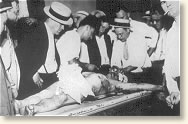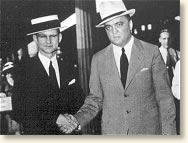Public Enemy #1 - John Dillinger
On the night of July 22, 1934, a team of FBI agents nervously waited in the sticky
heat outside the Biograph Theater in Chicago. They waited for John Dillinger,
Public Enemy #1. Shortly, the movie ended and the theater
 |
The bullet-riddled body of
John Dillinger in the morgue
July 23, 1934 |
released its audience
onto the street, John Dillinger among them. Using a prearranged signal, Melvin
Purvis, head of the FBI team, lit his cigar and three agents opened fire. The
hail of bullets wounded two bystanders and killed Dillinger. His death ended
a crime spree that had lasted only 11 months. In that short time his activities
captivated the imagination of the country creating a legend that persists today.
In May 1933 the thirty-year-old Dillinger walked out of a state prison after serving a nine-year sentence for robbing a grocery store. He immediately began a series of robberies to raise enough money to spring some of his fellow inmates.
He reached his goal in September and Dillinger provided the money that funded
the escape of 10 convicts (including his mentor, Harry Pierpont) from the state
prison. By that time, Dillinger himself was back in jail in Lima, Ohio. The
recent escapees returned Dillinger's favor by attacking the jail and freeing
him. The mob commenced a string of bank robberies across the Midwest and into
the Southwest where the spree ended in January 1934 with the gang's capture
in Tucson, Arizonia.
 |
FBI Director J. Edgar Hoover
congratulates Agent Purvis |
The Arizona authorities returned Dillinger to Crown Point, Indiana. However, this supposedly "escape proof" jail couldn't hold Dillinger. In March, he broke out (later claiming he used a wooden gun to do it), stole the sheriff's car, took two hostages and headed for the Illinois border. Once across the state line he released his hostages giving each $4.00 in compensation for the ordeal. Police caught up with him in St. Paul. Wounded in the subsequent shoot out, Dillinger still managed to get away.
In April, a phone call alerted the FBI that Dillinger and his gang were holed up in a Wisconsin resort called "Little Bohemia." Rushing
to the site, agents surrounded the house opening fire on three men leaving in
a car. Two were wounded, one killed, none were part of Dillinger's mob, just
working men who had stopped for a beer. After riddling the roadhouse with bullets,
the police charged in only to find their quarry had escaped out a back window.
Three months later, Dillinger's destiny caught up with him in an alley next to the Biograph Theater.
References:
Toland, John, The Dillinger Days (1963).
How To Cite This Article:
"Public Enemy #1 - John Dillinger," EyeWitness to History, www.eyewitnesstohistory.com (2000).
|






